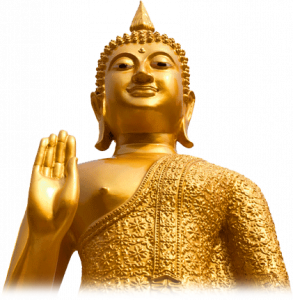
This image has format transparent PNG with resolution 293x300.
You can download this image in best resolution from this page and use it for design and web design.
Gautama Buddha PNG with transparent background you can download for free, just click on download button.
Gautama Buddha (c. 563/480 – c. 483/400 BCE), also known as Siddh?rtha Gautama, Shakyamuni (ie "Sage of the Shakyas") Buddha , or simply the Buddha, after the title of Buddha, was an ascetic (?rama?a) and sage, on whose teachings Buddhism was founded. He is believed to have lived and taught mostly in the eastern part of ancient India sometime between the 6th and 4th centuries BCE.
Gautama taught a Middle Way between sensual indulgence and the severe asceticism found in the ?rama?a movement common in his region. He later taught throughout other regions of eastern India such as Magadha and Kosala.
Gautama is the primary figure in Buddhism. He is believed by Buddhists to be an enlightened teacher who attained full Buddhahood and shared his insights to help sentient beings end rebirth and suffering. Accounts of his life, discourses and monastic rules are believed by Buddhists to have been summarised after his death and memorised by his followers. Various collections of teachings attributed to him were passed down by oral tradition and first committed to writing about 400 years later.
In Vaishnava Hinduism, the historic Buddha is considered to be an avatar of the Hindu god Vishnu. Of the ten major avatars of Vishnu, Vaishnavites believe Gautama Buddha to be the ninth and most recent incarnation.
The sources for the life of Siddh?rtha Gautama are a variety of different, and sometimes conflicting, traditional biographies. These include the Buddhacarita, Lalitavistara S?tra, Mah?vastu, and the Nid?nakath?. Of these, the Buddhacarita is the earliest full biography, an epic poem written by the poet A?vagho?a in the first century CE. The Lalitavistara S?tra is the next oldest biography, a Mah?y?na/Sarv?stiv?da biography dating to the 3rd century CE. The Mah?vastu from the Mah?s??ghika Lokottarav?da tradition is another major biography, composed incrementally until perhaps the 4th century CE. The Dharmaguptaka biography of the Buddha is the most exhaustive, and is entitled the Abhini?krama?a S?tra, and various Chinese translations of this date between the 3rd and 6th century CE. The Nid?nakath? is from the Theravada tradition in Sri Lanka and was composed in the 5th century by Buddhagho?a.
From canonical sources come the Jataka tales, the Mahapadana Sutta (DN 14), and the Achariyabhuta Sutta (MN 123), which include selective accounts that may be older, but are not full biographies. The J?takas retell previous lives of Gautama as a bodhisattva, and the first collection of these can be dated among the earliest Buddhist texts. The Mah?pad?na Sutta and Achariyabhuta Sutta both recount miraculous events surrounding Gautama's birth, such as the bodhisattva's descent from the Tu?ita Heaven into his mother's womb.
The Buddhist tradition regards Lumbini, in present-day Nepal to be the birthplace of the Buddha. He grew up in Kapilavastu. The exact site of ancient Kapilavastu is unknown. It may have been either Piprahwa, Uttar Pradesh, in present-day India, or Tilaurakot, in present-day Nepal. Both places belonged to the Sakya territory, and are located only 15 miles apart.
Gautama was born as a Kshatriya, the son of ?uddhodana, "an elected chief of the Shakya clan", whose capital was Kapilavastu, and who were later annexed by the growing Kingdom of Kosala during the Buddha's lifetime. Gautama was the family name. His mother, Maya, Suddhodana's wife, was a Koliyan princess. Legend has it that, on the night Siddhartha was conceived, Queen Maya dreamt that a white elephant with six white tusks entered her right side, and ten months later Siddhartha was born. As was the Shakya tradition, when his mother Queen Maya became pregnant, she left Kapilavastu for her father's kingdom to give birth. However, her son is said to have been born on the way, at Lumbini, in a garden beneath a sal tree.
The day of the Buddha's birth is widely celebrated in Theravada countries as Vesak. Buddha's Birthday is called Buddha Purnima in Nepal, Bangladesh, and India as he is believed to have been born on a full moon day. Various sources hold that the Buddha's mother died at his birth, a few days or seven days later. The infant was given the name Siddhartha (P?li: Siddhattha), meaning "he who achieves his aim". During the birth celebrations, the hermit seer Asita journeyed from his mountain abode and announced that the child would either become a great king (chakravartin) or a great sadhu. By traditional account, this occurred after Siddhartha placed his feet in Asita's hair and Asita examined the birthmarks. Suddhodana held a naming ceremony on the fifth day, and invited eight Brahmin scholars to read the future. All gave a dual prediction that the baby would either become a great king or a great holy man. Konda??a, the youngest, and later to be the first arhat other than the Buddha, was reputed to be the only one who unequivocally predicted that Siddhartha would become a Buddha.
While later tradition and legend characterised ?uddhodana as a hereditary monarch, the descendant of the Suryavansha (Solar dynasty), many scholars think that ?uddhodana was the elected chief of a tribal confederacy.
Early texts suggest that Gautama was not familiar with the dominant religious teachings of his time until he left on his religious quest, which is said to have been motivated by existential concern for the human condition. The state of the Shakya clan was not a monarchy and seems to have been structured either as an oligarchy, or as a form of republic. The more egalitarian gana-sangha form of government, as a political alternative to the strongly hierarchical kingdoms, may have influenced the development of the ?ramanic Jain and Buddhist sanghas, where monarchies tended toward Vedic Brahmanism.
In this page you can download free PNG images: Gautama Buddha PNG images free download